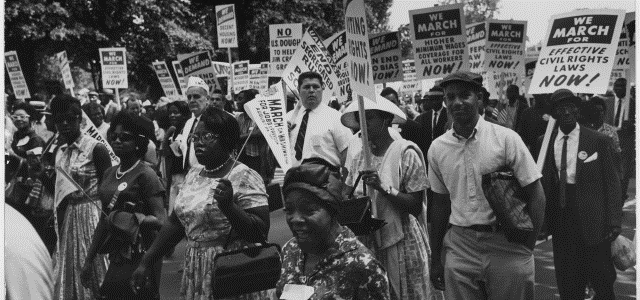 Wednesday marks 50 years since more than 250,000 people joined the March on Washington for Jobs and Freedom and pushed the government to extend civil and economic rights to African Americans. A massive rally where the Rev. Martin Luther King Jr. made his historic “I Have a Dream” speech on the steps of the Lincoln Memorial, it has been credited with spurring passage of the 1964 Civil Rights Act and the Voting Rights Act of 1965.
Wednesday marks 50 years since more than 250,000 people joined the March on Washington for Jobs and Freedom and pushed the government to extend civil and economic rights to African Americans. A massive rally where the Rev. Martin Luther King Jr. made his historic “I Have a Dream” speech on the steps of the Lincoln Memorial, it has been credited with spurring passage of the 1964 Civil Rights Act and the Voting Rights Act of 1965.
Fifty years after the march, the movement has expanded. Events to mark the March on Washington’s anniversary highlight the unfulfilled goals of ongoing civil rights issues—like immigration reform—that still face the nation. On Saturday, as people retraced the steps of the first march, several speakers compared the efforts to reform immigration laws and help the 11 million undocumented immigrants living in the U.S. to African Americans’ fight for civil rights. “It doesn’t make sense that millions of our people are living in the shadows,” Rep. John Lewis (D-GA), who also spoke at the 1963 march, said on Saturday. “Bring them out into the light and set them on the path to citizenship.”
And Janet Murguia, president of the National Council of La Raza, said the shared civil rights struggle of African Americans and immigrants has a long history back to the original march. “Dr. King’s words resonated not just with one community, but with many,” Murguia said. Before the march and years before the U.S. Supreme Court ended racial segregation in U.S. schools with Brown v. Board of Education, a federal circuit court in California ruled that segregation of school children was unconstitutional in a case involving Mexican American school children. The historic decision in the case of Mendez v. Westminster in 1947 became critical to the strategic choices and legal analysis used in arguing Brown. More broadly, however, the case also symbolized the important crossover between different ethnic and racial groups who came together to argue in favor of desegregation.
In another sign of the connection between the movements, the Associated Press explains that the civil rights movement in the 1960s led to the first steps of immigration reform:
It was with the Immigration and Nationality Act of 1965 that the federal government radically altered immigration policy, opening America’s doors to the world after decades of keeping them shut to entire geographic regions. That decision planted the seeds for the demographics explosion the country is living in now, a shift that historians say happened in part because of a hunger for change and equality created by the civil rights movement.
The movement “broke through the whole aura of political stagnation that was created by the McCarthy era and the Cold War, and allowed us to imagine another” world, said Mark Naison, professor of African-American studies and history at Fordham University in New York. “It was the civil rights movement…that broke through the logjam and allowed people to talk about real issues in our domestic lives.”
In the last 50 years, the immigrant population has also changed dramatically. The foreign-born population made up 5.4 percent of the U.S. population in 1960 according to Census data, with 75 percent of immigrants coming from Europe. In 2010, the foreign-born population accounts for 13 percent of the U.S. population and 53 percent of immigrants come from Latin America. The 50th anniversary of the march that spurred the government into action on civil rights is another reminder that the fight for fairness and justice in all its many forms is far from over.
FILED UNDER: civil rights immigration, Immigration and Martin Luther King, immigration legislation, immigration reform, undocumented immigration


